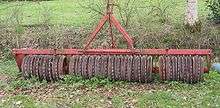Cultipacker


A cultipacker is a piece of agricultural equipment that crushes dirt clods, removes air pockets, and presses down small stones, forming a smooth, firm seedbed. Where seed has been broadcast, the roller gently firms the soil around the seeds, ensuring shallow seed placement and excellent seed-to-soil contact.
The cultipacker differs from the field roller in that it is made up of many sections that form peaks and valleys in the soil where the cultipacker has been used.
The term cultipacker is almost exclusively applied to ridged packers, while the term roller may refer to either a smooth or a ridged packer. The term cultipacker appeared in English around 1914 and may have originated as a brand name. By the 1920s and ever since, it has been widely used in a genericized sense.